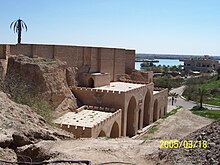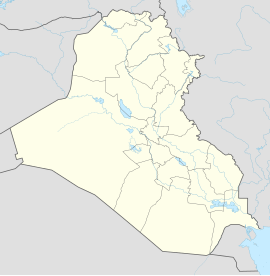Tikrit
| Tikrit | ||
|---|---|---|
| location | ||
|
|
||
| Coordinates | 34 ° 36 ' N , 43 ° 41' E | |
| Country |
|
|
| Governorate | Salah ad-Din | |
| Basic data | ||
| height | 110 m | |
| Residents | 185,000 (2014) | |
| Tikrit, around 2004 | ||
Tikrit ( Arabic تكريت, DMG Tikrīt , also called Takrit ) is an Iraqi city on the Tigris River with over 100,000 inhabitants (exact population unknown; 260,000 (2003); 190,220 (2012, estimate)) about 160 km northwest of Baghdad with an almost exclusively Sunni population. Tikrit is the capital of the Salah ad-Din province . In Syrian works the city is called Taghrith .

history
The first reliable mention of the city can be found in Claudius Ptolemy (2nd century), who named the city Birtha. Today part of the city is still called Burtha. According to Arab authors, the city is said to have been founded by the Sassanid king Shapur I (r. 240 / 42–270 AD). The current name Tikrit is popularly derived from a Christian woman named Takrit bint Wail. Before the Islamization of the region, the city was inhabited by Christian Arabs. In 637 Tikrit was conquered for the first time by the Muslim Arabs. In the early Islamic centuries, Tikrit was an entirely Christian city. Tikrit was a Jacobite bishopric as early as the 4th century until the diocese of Tikrit was merged with that of Mosul in 1155 . The liturgical language of Christians was the Syrian language. Some churches and Christian buildings are now in ruins. Although the city did not play an important role in history, it was able to produce some Christian scholars. In the Middle Ages, Tikrit was the seat of the Maphrians , the metropolitan of the Syrian Orthodox Church immediately after the Patriarch .
In the 11th century, the Seljuks under Tughrul Beg conquered the city. From 1149 the city belonged to the principality of Erbil , then in 1190 it became the property of the Abbasid caliphs. The Zengids later followed the caliphs . Saladin , a follower of the Zengids and later founder of the Ayyubids , was born here in 1137 . Many Christians still lived here in the 12th century. In the 14th century Tikrit was devastated by Timur and decreased in importance, so that in the 19th century no more than 4000 to 5000 people lived here. In the 16th century Tikrit was Ottoman and remained so until 1917, when it is the British during the First World War conquered. Tikrit became part of the British mandate of Mesopotamia after the end of the World War .
Tikrit is the birthplace of the long-time Iraqi ruler Saddam Hussein , who was executed on December 30, 2006, and was the headquarters of his family clan . Hussein pushed the expansion of the city. In the post-Hussein era, the city became known as the center of resistance against the US occupation of Iraq.
In 2014, Tikrit came under IS control . This resulted in the Tikrit massacre of Iraqi soldiers. ISIS was expelled in the Battle of Tikrit in March 2015.
geography
Tikrit lies on the west bank of the Tigris . A single bridge connects the city with the area on the other side of the river.
Tikrit has a university. There are Camp Speicher , Tikrit South Airport and Tikrit East Airport in the vicinity .
Striking is a palace of Saddam Hussein.
sons and daughters of the town
- Saladin
- Saddam Hussein
- Ahmad Hasan al-Bakr
- Hardan at-Tikriti , military and politician
- Barzan Ibrahim at-Tikriti , politician
- Chairallah Talfah
- Adnan Chairallah
literature
- The Encyclopaedia of Islam. New Edition , article Takrīt by JH Kramers- [CE Bosworth]
- JM Fiey: Tagrit. Esquisse de l'histoire chrétienne , in: L'Orient Syrien 8 (1963) pp. 289–342.
Web links
Individual evidence
- ^ Background on Mosul and Tikrit. ARD, archived from the original on March 18, 2015 ; Retrieved June 29, 2014 .
- ^ Tikrit City. University of Tikrit, accessed June 29, 2014 .


